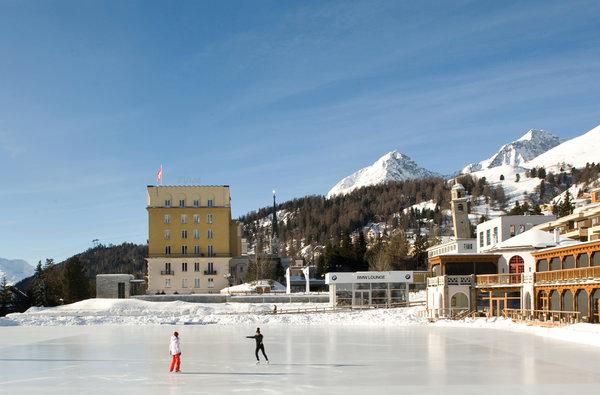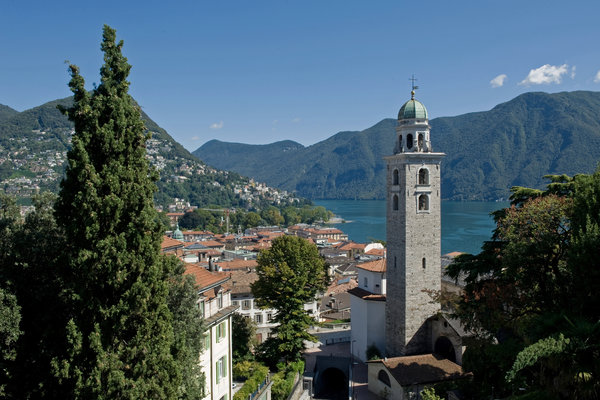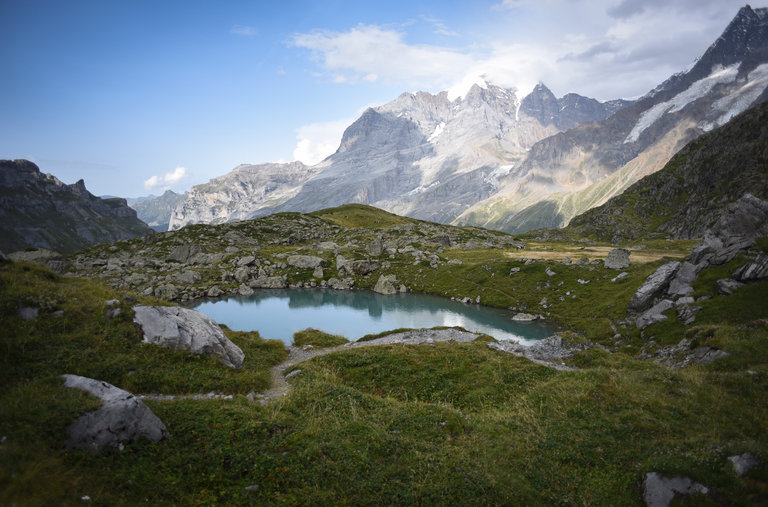A tiny Swiss mountain town with a big, glitz-infused name, St. Moritz is the winter getaway that made the ski holiday a high-life ideal. As far back as the 1860s, a patrician British contingent was spending the cold months in the winter sun here; by the 1960s, the jet set had anointed St. Moritz the hallowed ski spot of wealthy scions and the internationally fabulous. In the town’s handful of streets jumbled along the western banks of St. Moritz Lake, the German- and Romansch-speaking enclave is home to a mere 5,200 citizens, joined by more than half a million glamour-hungry visitors each year. Amid all the dazzle and dizzying prices though, the town’s roots endure: Swiss, snowbound and sports-obsessed. Tourist life remains old-fashioned, revolving around the ski lodges and the storied Kulm, the slope-side Suvretta and the buzz-filled Badrutt’s Palace, the grand hotels where heavy Alpine furniture never goes out of style; piano players still serenade the lounge-dwellers and old- and new-moneyed denizens alike sip champagne under dim chandeliers.
Friday
1) 2 p.m. Ski in the city
A host of the Winter Olympics in 1928 and 1948, St. Moritz is prime snow-sports territory, with a paradise of idyllic paths for cross-country skiing, snowshoeing and sledding. Still, downhill skiing is the siren call of these mountains. Outside town, Corvatsch offers skiers daredevil verticality, but St. Moritz’s own Corviglia has glorious expanses of snowy slopes. (Day passes start at 50 Swiss francs, or about $50, depending on the week.) Warm up frozen toes afterward with a hot drink at Alpinahütte, where you’ll find skiers reviving with glühwein (mulled wine), skiwasser (hot water with raspberry syrup and lemon) and bull shots, a 17-Swiss-franc concoction of vodka and consommé.
2) 6:30 p.m. Aperitivo
Badrutt’s Palace, with its green-tipped tower marking the bull’s-eye of Via Serlas, is the heart of St. Moritz society. The hotel’s remodeled King’s Social House, said to be the oldest club in Switzerland, serves dinner and cocktails to a crowd that stays late to dance in its basement lounge. But there’s even more action at the plush Renaissance Bar: Badrutt’s pocket-size, antique smoking lounge, known to regulars as Mario’s, after the now-retired barman there. Around the fireplace, scores of merrymakers pack the velvet banquettes and armchairs, lighting cigars with matches in sterling silver cases and inviting new acquaintances for rounds of Mario’s signature cocktails (like the hot negroni, with Campari, red wine, cranberry and juniper berries for 25 francs) and the popular club sandwich (available for home delivery, via Badrutt’s slick black Rolls-Royce).
3) 9 p.m. Dinner and dancing
Sure, most of the Moncler-clad masses are here to ski, but why here? For the après-ski scene. At La Baracca, neighborly fraternizing over dinner is the norm, and dancing both around and on the long tables generally ensues soon after. The music is loud; the food is unadorned Alpine home cooking, with dishes like beef carpaccio with pesto and mashed potatoes (49.50 Swiss francs). The restaurant itself is a former construction shack plunked in a parking lot, with whimsically cockeyed vintage chandeliers and red roses in ice buckets. And in this glaringly posh town, it’s an intimate and unpretentious affair that packs in locals and party-loving visitors.

The Kulm Country Club, a storied chalet, overlooks the plein-air ice-skating rink in the Olympic Park.CreditAndrea Wyner for The New York Times
Saturday
4) 8 a.m. Breakfast treats
In the morning, head to Hanselmann’s pastry shop, a classic since 1894, whose elaborate rose- and buttercream-swirled exterior signals the sugarcoated delights within. A full breakfast menu offers eggs and other savory ways to start the day, but the bakery’s cases of croissants and cakes will most likely convince you of sweeter plans. For those ready to dive into slices of Hanselmann’s saccharine goodness, there’s no better place to try an Engadine nusstorte specialty: a sticky shortbread confection of walnuts and caramel (4 francs) to be enjoyed with coffee.
5) 10 a.m. Steam therapy
For those in need of a bit of recovery after the previous day’s slopes, the Ovaverva bathhouse (entrance, 30 Swiss francs) is a sleek Swiss palace of modern spa facilities. It features saunas, steam rooms, hot tubs, an outdoor heated pool and relaxation rooms fronted by sprawling glass walls with a view of the pines and the mountains. Note that no bathing suits are allowed in the saunas, but there are both mixed and women-only facilities. Kiddie pools offer entertainment for the very young, and some invigoratingly fast water slides offer thrills for all ages. A full line of massages can be arranged (60 to 185 Swiss francs), but for more serious treatment, Heilbad next door offers medical-grade physical therapy and therapeutic massages (55 to 120 Swiss francs).
6) Noon. Lunch on high
Strap on your snow gear and head for the peaks to glimpse the summit-surrounded valley that nestles little St. Moritz in its lakeside basin. The Chasellas ski lift — an eight-minute glide above the mountainside — deposits straphangers at the Suvretta Hotel’s Trutz Chalet, a lunchtime oasis of old-fashioned stone and timber at 7,200 feet above sea level, with views over the whole of the Upper Engadine. As skiers slalom by the chalet’s picture windows, diners in moon boots fuel up with the simple, robust dishes of Alpine lodge cuisine: rösti potato pancakes and bratwurst, polenta with porcini mushrooms, lamb Wiener schnitzel and more. Lunch plates average around 30 Swiss francs.
7) 2:30 p.m. Singular souvenirs
Via Serlas and its byways have the standard international luxury names to be expected in any global destination this glittery — Bulgari, Gucci, Prada and the like — but a number of niche boutiques make shopping in St. Moritz special. Faoro, a stylish clothing store with a cafe, sells its own line of Italian-made sweaters and smart-looking versions of traditional bündner mountain-guide outfits. A few doors down, Ebneter Biel uses a fleet of embroiderers to stitch tablecloths and napkins with everything from local fauna to seminude cabaret dancers; it also sells lederhosen for children and traditional leather Appenzeller belts that are fascinatingly studded with metallic cows, horses and starry emblems. Nearby, Lamm has been devoted to all things cashmere since 1935, and the annual winter pop-up Cabana sells a personality-filled selection of tableware, from hand-painted Limoges to Murano glass.
8) 4:30 p.m. Snack shop
Several St. Moritz shops offer Alpine specialties that deserve a taste. Pur Alps has a casual cafe, and sells six varieties of apple juice in its shop, along with jams, cheeses and other local products. At Hatecke, fourth-generation butchers in a modern shop, have vacuum-packed, housemade lamb, venison and other sausages, and serve a small menu of fresh soups and sandwiches. And you weren’t going to leave Switzerland without chocolates, were you? At Läderach, a dizzying array of sumptuously cocoa-rich truffles, barks and holiday morsels await.
9) 8:30 p.m. New Alpine cuisine
With its Alpine recipes of locally sourced ingredients, the petite Dal Mulin is the rare St. Moritz restaurant that serves elegant, inspired food and doesn’t glut its menu with heavy interpretations of Italian standards or additions of lobster, caviar and truffle to justify big-ticket prices. Dishes, which rely on locally sourced ingredients, include a light beetroot soup, enlivened with a careful balance of horseradish and caraway seeds. Mains, like seared codfish with salsify and miso hollandaise (52 Swiss francs), and venison loin with savoy cabbage, celery and juniper (58 Swiss francs), are complemented by an extensive, thoroughly researched wine list.
10) 11 p.m. Nightcap
The long, snooty shadow of St. Moritz’s old winter gentry is still discernible in the remaining private clubs — sporting associations by origin — that are key to social life here. The Corviglia Club is linked to the mountain’s ski lodge, while the Cresta Club’s small numbers rally around its toboggan run, a death-defying, headfirst solo journey down an ice-covered chute, which opened in 1884 and is allowing women to ride for the first time this year. But in the darkest hours, Dracula is the place to go. Linked to the Olympic Park’s bob run, the club was started by the photographer, industrialist and infamous playboy Gunter Sachs in 1974. Today the lofty wooden lodge serves cocktails and occasionally hosts bands. Though entrance is reserved for club members and their acquaintances, guests of the Kulm hotel, Suvretta and Badrutt’s Palace can get help reserving from the concierge. Others can try their luck by arriving, decently dressed, before midnight.
Sunday
11) 11 a.m. Fast track
For a jolt of a joy ride, walk through the lovely spruce-lined knolls of Kulm park, past the iconic 1928 Olympic Stadium restored by artist Rolf Sachs as his private home, to the starting point of the fabled St. Moritz-Celerina bob run. Intrepid visitors can book a high-speed trip, equipped with little more than a sleigh and a helmet to hurdle down the ice of what’s billed as the world’s only naturally occurring bob trail. Bobsleds carry four passengers; up to two may be novices. The hefty 269-Swiss-franc ticket includes a celebratory pin and certificate and a glass of bubbly to take the edge off. Observing is free, and electrifying.
12) 2:30 p.m. Snacks and skates
For snacks and hot chocolate, stop by the Kulm Country Club, a storied chalet recently remodeled by Norman Foster, a part-time St. Moritz resident who also designed the timber-shingled blob that is the Chesa Futura private residence (the most arrestingly contemporary architecture in town). The club overlooks the plein-air ice-skating rink in the Olympic Park, which offers skate rentals for 22 Swiss francs. It’s filled with contemporary furnishings and vintage relics of local sports: Wooden bobsleds line the ceiling, old ski poles mark the doors and black-and-white photos of St. Moritz’s Olympic competitions festoon the walls.
13) 4 p.m. Art in the Alps
St. Moritz and the Engadin Valley that encompasses it have a long history of attracting artists and intellectuals — Friedrich Nietzsche, Alberto Giacometti, Thomas Mann, Hermann Hesse and Giovanni Segantini, among them. In recent years, that cultural legacy has flowered anew, with the openings of contemporary art venues like the Muzeum Susch, the Stalla Madulain, the artist Not Vital’s castle-turned-gallery and the art-filled Hotel Castell, all in the surrounding valley. A stroll around the town itself offers its own enlightening treats. Stop by the Segantini Museum before it closes in March for renovations to view the artist’s works, including his significant “Life, Nature and Death” triptych. In a sign of St. Moritz’s burgeoning importance in the art world, Hauser & Wirth opened with a Louise Bourgeois show in a three-story Via Serlas space in December.
Lodging
There are several three-star hotels that possess a fair amount of comfort and decorum, and cost a fraction of luxury lodgings. Built in 1875, the Hotel Reine Victoria retains some of the tasseled curtain and gilded charm of its Belle Époque origins; its relatively bargain-priced rooms start at 175 Swiss francs and include entrance to the neighboring Ovaverva bathhouse.
Airbnb can provide some relief off-peak, but on average, a one-bedroom apartment is still pricey, costing from 225 to 1,200 Swiss francs a night, with prices surging drastically during holiday weeks.
The Kulm, one of St. Moritz’s grand hotels and the first to open its doors here in 1856, offers both an august history and a slew of newly renovated rooms by the designer Pierre Yves-Rochon that feature fragrant, native stone pine wood. Doubles start from 545 Swiss francs. The spa and heated outdoor pool, like most of the balconied rooms, overlooks the lake and mountains.








